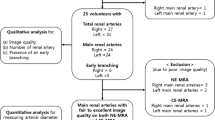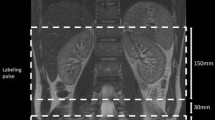Abstract
The purpose was to evaluate the image quality of high-spatial resolution MRA of the renal arteries at 1.5 T after contrast-agent injection of 0.2 mmol/kg body weight (BW) in an interindividual comparison to 3.0 T after contrast-agent injection of 0.1 mmol/kg BW contrast agent (CA). After IRB approval and informed consent, 40 consecutive patients (25 men, 15 women; mean age 53.9 years) underwent MRA of the renal arteries either at a 1.5-T MR system with 0.2 mmol/kg BW gadobutrol or at a 3.0-T MR scanner with 0.1 mmol/kg BW gadobenate dimeglumine used as CA in a randomized order. A constant volume of 15 ml of these contrast agents was applied. The spatial resolution of the MRA sequences was 1.0 × 0.8 × 1.0 mm3 at 1.5 T and 0.9 × 0.8 × 0.9 mm3 at 3.0 T, which was achieved by using parallel imaging acceleration factors of 2 at 1.5 T and 3 at 3.0 T, respectively. Two radiologists blinded to the administered CA and the field strength assessed the image quality and the venous overlay for the aorta, the proximal and distal renal arteries independently on a four-point Likert-type scale. Phantom measurements were performed for a standardized comparison of SNR at 1.5 T and 3.0 T. There was no significant difference (p > 0.05) between the image quality at 3.0 T with 0.1 mmol/kg BW gadobenate dimeglumine compared to the exams at 1.5 T with 0.2 mmol/kg BW gadobutrol. The median scores were between 3 and 4 (good to excellent vessel visualization) for the aorta (3 at 1.5 T/4 at 3.0 T for reader 1 and 2). For the proximal renal arteries, median scores were 3 for the left and right renal artery at 1.5 T for both readers. At 3.0 T, median scores were 3 (left proximal renal artery) and 4 (right proximal renal artery) for reader 1 and 3 (left/right) for reader 2 at 3.0 T. For the distal renal arteries, median scores were between 2 and 3 at both field strengths (moderate and good) for both readers. The κ values for both field strengths were comparable and ranged between 0.571 (moderate) for the distal renal arteries and 0.905 (almost perfect) for the proximal renal arteries. In the phantom measurements, a 40% higher SNR was found for the measurements at 3 T with gadobenate dimeglumine. High-spatial resolution renal MRA at 3.0 T with 0.1 mmol/kg BW gadobenate dimeglumine yields at least equal image quality compared with renal MRA at 1.5 T with 0.2 mmol/kg BW gadobutrol.





Similar content being viewed by others
References
Prince MR (1994) Gadolinium-enhanced MR aortography. Radiology 191:155–164
Tan KT, van Beek EJ, Brown PW et al (2002) Magnetic resonance angiography for the diagnosis of renal artery stenosis: a meta-analysis. Clin Radiol 57:617–624
Pruessmann KP, Weiger M, Scheidegger MB, Boesiger P (1999) SENSE: sensitivity encoding for fast MRI. Magn Reson Med 42:952–962
Griswold MA, Jakob PM, Heidemann RM et al (2002) Generalized autocalibrating partially parallel acquisitions (GRAPPA). Magn Reson Med 47:1202–1210
Nael K, Michaely HJ, Villablanca P et al (2006) Time-resolved contrast enhanced magnetic resonance angiography of the head and neck at 3.0 Tesla: Initial results. Invest Radiol 41:116–124
Reeder SB, Wintersperger BJ, Dietrich O et al (2005) Practical approaches to the evaluation of signal-to-noise ratio performance with parallel imaging: application with cardiac imaging and a 32-channel cardiac coil. Magn Reson Med 54:748–754
Campeau NG, Huston J, 3rd, Bernstein MA, Lin C, Gibbs GF (2001) Magnetic resonance angiography at 3.0 Tesla: initial clinical experience. Top Magn Reson Imaging 12:183–204
Runge VM, Biswas J, Wintersperger BJ et al (2006) CMR 2005: 6.03: The efficacy of MultiHance (gadobenate dimeglumine or Gd-BOPTA) at 1.5 and 3 T in a rat brain glioma model. Contrast Media Mol Imaging 1:68–69
Fenchel M, Nael K, Deshpande VS et al (2006) Renal magnetic resonance angiography at 3.0 Tesla using a 32-element phased-array coil system and parallel imaging in 2 directions. Invest Radiol 41:697–703
Michaely HJ, Nael K, Schoenberg SO et al (2005) The feasibility of spatial high-resolution magnetic resonance angiography (MRA) of the renal arteries at 3.0 T. Rofo 177:800–804
de Bazelaire CM, Duhamel GD, Rofsky NM, Alsop DC (2004) MR imaging relaxation times of abdominal and pelvic tissues measured in vivo at 3.0 T: preliminary results. Radiology 230:652–659
Rohrer M, Bauer H, Mintorovitch J, Requardt M, Weinmann HJ (2005) Comparison of magnetic properties of MRI contrast media solutions at different magnetic field strengths. Invest Radiol 40:715–724
Nael K, Michaely HJ, Lee M et al (2006) Dynamic pulmonary perfusion and flow quantification with MR imaging, 3.0T vs. 1.5T: initial results. J Magn Reson Imaging 24:333–339
Tombach B, Benner T, Reimer P et al (2003) Do highly concentrated gadolinium chelates improve MR brain perfusion imaging? Intraindividually controlled randomized crossover concentration comparison study of 0.5 versus 1.0 mol/L gadobutrol. Radiology 226:880–888
Schoenberg SO, Rieger J, Weber CH et al (2005) High-spatial-resolution MR angiography of renal arteries with integrated parallel acquisitions: comparison with digital subtraction angiography and US. Radiology 235:687–698
Trattnig S, Pinker K, Ba-Ssalamah A, Nöbauer-Huhmann IM (2006) The optimal use of contrast agents at high field MRI. Eur Radiol 16:1280–1287
Zech CJ, Herrmann KA, Huber A et al (2004) High-resolution MR-imaging of the liver with T2-weighted sequences using integrated parallel imaging: comparison of prospective motion correction and respiratory triggering. J Magn Reson Imaging 20:443–450
Knopp MV, Schoenberg SO, Rehm C et al (2002) Assessment of gadobenate dimeglumine for magnetic resonance angiography: phase I studies. Invest Radiol 37:706–715
Kirchin MA, Runge VM (2003) Contrast agents for magnetic resonance imaging: safety update. Top Magn Reson Imaging 14:426–435
Michaely HJ, Dietrich O, Nael K et al (2006) MRA of abdominal vessels: technical advances. Eur Radiol 16:1637–1650
Herborn CU, Lauenstein TC, Ruehm SG et al (2003) Intraindividual comparison of gadopentetate dimeglumine, gadobenate dimeglumine, and gadobutrol for pelvic 3D magnetic resonance angiography. Invest Radiol 38:27–33
Tombach B, Heindel W (2002) Value of 1.0- M gadolinium chelates: review of preclinical and clinical data on gadobutrol. Eur Radiol 12:1550–1556
Goyen M, Lauenstein TC, Herborn CU et al (2001) 0.5 M Gd chelate (Magnevist) versus 1.0 M Gd chelate (Gadovist): dose-independent effect on image quality of pelvic three-dimensional MR-angiography. J Magn Reson Imaging 14:602–607
Knopp MV, von Tengg-Kobligk H, Floemer F, Schoenberg SO (1999) Contrast agents for MRA: future directions. J Magn Reson Imaging 10:314–316
Cavagna FM, Maggioni F, Castelli PM et al (1997) Gadolinium chelates with weak binding to serum proteins. A new class of high-efficiency, general purpose contrast agents for magnetic resonance imaging. Invest Radiol 32:780–796
Kirchin MA, Pirovano GP, Spinazzi A (1998) Gadobenate dimeglumine (Gd-BOPTA). An overview. Invest Radiol 33:798–809
Goyen M, Debatin JF (2003) Gadobenate dimeglumine (MultiHance) for magnetic resonance angiography: review of the literature. Eur Radiol 13(3):N19–N27
Thomsen HS (2006) Nephrogenic systemic fibrosis: a serious late adverse reaction to gadodiamide. Eur Radiol 16:2619–2621
Broome DR, Girguis MS, Baron PW et al (2007) Gadodiamide-associated nephrogenic systemic fibrosis: why radiologists should be concerned. AJR Am J Roentgenol 188:586–592
Grobner T (2006) Gadolinium-a specific trigger for the development of nephrogenic fibrosing dermopathy and nephrogenic systemic fibrosis? Nephrol Dial Transplant 21:1104–1108
Boyd AS, Zic JA, Abraham JL (2007) Gadolinium deposition in nephrogenic fibrosing dermopathy. J Am Acad Dermatol 56:27–30
Thomsen HS (2007) European Society of Urogenital Radiology guidelines on contrast media application. Curr Opin Urol 17:70–76
Rinck PA, Muller RN (1999) Field strength and dose dependence of contrast enhancement by gadolinium-based MR contrast agents. Eur Radiol 9:998–1004
Allkemper T, Heindel W, Kooijman H, Ebert W, Tombach B (2006) Effect of field strengths on magnetic resonance angiography: comparison of an ultrasmall superparamagnetic iron oxide blood-pool contrast agent and gadopentetate dimeglumine in rabbits at 1.5 and 3.0 tesla. Invest Radiol 41:97–104
Hany TF, McKinnon GC, Leung DA et al. (1997) Optimization of contrast timing for breath-hold three-dimensional MR angiography. J Magn Reson Imaging 7:551–556
Author information
Authors and Affiliations
Corresponding author
Additional information
Ulrike I. Attenberger and Henrik J. Michaely contributed equally.
Rights and permissions
About this article
Cite this article
Attenberger, U.I., Michaely, H.J., Wintersperger, B.J. et al. Three-dimensional contrast-enhanced magnetic-resonance angiography of the renal arteries: Interindividual comparison of 0.2 mmol/kg gadobutrol at 1.5 T and 0.1 mmol/kg gadobenate dimeglumine at 3.0 T. Eur Radiol 18, 1260–1268 (2008). https://doi.org/10.1007/s00330-008-0873-5
Received:
Revised:
Accepted:
Published:
Issue Date:
DOI: https://doi.org/10.1007/s00330-008-0873-5




